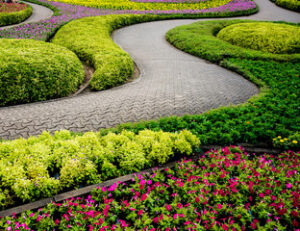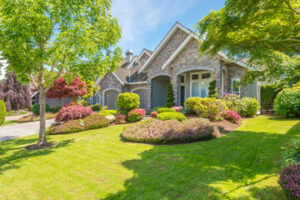Jupiter Landscaping is a technique that involves designing and building outdoor spaces. It helps to improve the overall appearance of a property, add functionality and increase the value of homes.

Hardscapes include structures like patios, walkways, retaining walls and driveways. They should be made from durable materials that will withstand weather conditions.
Landscaping goes beyond lawn care and focuses on the total aesthetic of your property. It incorporates hardscape elements like patios, walkways, retaining walls, and decks with plants, flowers, trees, and shrubs all harmonized by thoughtful design principles. It also supports biodiversity and minimizes soil erosion. It also helps you save energy by shading your home in the summer and blocking undesirable views during winter.
Landscapes help you improve your mental health by reducing stress, promoting relaxation, and improving mood. Lush green spaces are natural escapes from urban stressors and provide an opportunity for physical activity. Additionally, landscaping can reduce noise pollution by creating natural privacy screens and buffers.
Quality landscaping increases the appeal of neighborhoods and homes, resulting in increased property values. It can also lower the cost of heating and cooling by providing shade, reducing air temperatures, and lowering wind speeds. Properly placed plants can also reduce the amount of pollutants in the air and prevent soil erosion.
When properly designed, your landscape can be a mini-ecosystem. Native plants attract pollinators and wildlife, and trees help remove carbon dioxide from the atmosphere. Well-maintained landscapes can even help you avoid pesticide exposure by minimizing the use of chemicals.
In addition, studies show that commercial businesses see a higher success rate and customer satisfaction when they are located near green spaces or well-designed landscaping. People are more likely to spend money in a business with a nice outdoor environment and will travel further to shop at a store with a tree-filled canopy. And don’t forget the social benefits! Spending time with friends and family in a beautiful landscaped setting promotes health, well-being, and happiness.
Beauty
A well-done landscape design enhances the visual appeal of your home and property. A great way to separate your house from the surrounding competition when selling, it shows that you take pride in your property and value its beauty. This is important to buyers as it gives them a sense of what living in the property will be like.
Landscaping can also prevent hazards such as diseased trees falling on your house, stinging or allergen-producing plants coming into contact with you or your family, or unwelcome animals taking up residence in your yard. A professional landscaper can make sure that your landscape is a safe environment for you and your family as well as the local flora and fauna.
You can also enjoy your yard without having to worry about bugs, since many plants emit odors that deter pests like gnats, flies, and mosquitoes. The aromas produced by these plants are pleasant to humans but unpleasant to insects.
Eco-friendliness
A major benefit of eco-friendly landscaping is the preservation of natural resources. This is accomplished through various practices including water conservation techniques, planting native and drought-tolerant plants, promoting biodiversity, and using environmentally responsible materials in your outdoor space.
These practices result in beautiful, low-maintenance landscapes that enhance the aesthetic of your property and contribute to a greener future. They also provide financial savings through reduced chemical inputs, lower water bills, and maintenance costs. Incorporating sustainability into your landscape design is also a great way to increase the marketability of your home or business by providing potential buyers with an appealing environment they can appreciate and maintain.
Choosing native plants that are adapted to your climate and soil type reduces the need for fertilizers and chemicals while contributing to a healthy ecosystem. Installing a rain garden to manage stormwater runoff is another great way to conserve water while beautifying your property. Creating wildlife habitat and using mulch to improve soil health promotes biodiversity and supports a balanced and vibrant natural environment. Moreover, minimizing energy consumption and greenhouse gas emissions by using solar-powered lighting, reducing lawn sizes, and selecting efficient irrigation systems helps reduce utility costs.
Sustainable hardscapes, such as permeable pavers and recycled concrete, reduce the amount of energy used in their production, installation, and use. Incorporating sustainable materials into your landscape also reduces the amount of waste produced. Additionally, incorporating compost into your garden and utilizing it as a top-dressing for plants improves soil fertility and decreases the need for synthetic fertilizers.
Changing your landscape to utilize more eco-friendly practices can be daunting, but it’s important to keep in mind that it doesn’t have to be. Start small by focusing on areas that can be easily changed and add more features over time as you grow in confidence.
Aesthetics
Landscaping is a creative way to enhance the beauty of your home. It also increases property value, improves the environment, and provides many benefits for your family. Whether you’re looking for a tranquil retreat or an entertainment area, landscaping can meet your needs. It reduces soil erosion and water runoff, creates habitats for wildlife, and promotes energy efficiency by shading your home with trees and shrubs.
Although the word “aesthetic” is often used to describe the outer appearance of something, its deeper meaning is about pleasure and enjoyment. Unlike science, which is concerned with the material world in and of itself, aesthetics concerns the experience of the world – its beauty, harmony, and symmetry – as perceived by people.
Aesthetics has its origin in ancient civilizations, where people manipulated their land to grow crops and create gardens. Today, the practice continues to thrive with modern technological developments and scientific research into how landscape elements interact with each other.
There are several ways to make your garden more beautiful, including water features, rock gardens, and outdoor structures like gazebos and pergolas. Plants are also chosen for their shape, color, and texture to add visual intrigue. Ornaments like lanterns and statues can be placed throughout the garden for interest.
The book merges the concepts of aesthetics and environmental stewardship, guiding readers to create gardens that are both visually appealing and sustainable over time. It echoes the philosophy of renowned plantsman Piet Oudolf, who believes that beauty in nature should be functional and contribute to ecosystem health. It also teaches readers to choose species that fulfill aesthetic roles while providing food and shelter for wildlife, promoting a harmonious relationship between dwellings and their surroundings.
Value
Landscaping is not just about “pretty.” It’s also about increasing the value of your property. Many real estate professionals believe that well-maintained landscaping can increase a home’s value by 10-15%. And, unlike many home renovation projects, landscapes are a relatively low-cost way to improve your home’s curb appeal.
Landscaping involves choosing and planting trees, flowers, shrubs, and groundcovers that suit your climate and soil conditions. It can also include the design and construction of hardscape features such as walkways, patios, and retaining walls. Landscaping professionals are skilled at combining these elements to create functional and attractive outdoor spaces that complement the architectural style of your home.
Aside from its aesthetic appeal, landscaping has several environmental benefits. Trees reduce soil erosion, provide shade, and help to improve air quality. They can also reduce energy costs and provide a natural habitat for wildlife. Additionally, landscaping can help to prevent water runoff and drainage issues.
The services offered by professional landscaping companies can be divided into two categories: hardscape and softscape. Hardscape refers to non-living elements such as paving materials, structures, and fences. Softscape includes plants and other living elements such as grass, soil, and waterways. Landscaping professionals can also install and maintain irrigation systems and garden lighting.
Whether you’re looking to improve your home’s curb appeal or simply want to enjoy the outdoors, landscaping is a great choice. With its many health, aesthetic, and environmental benefits, it’s no wonder that landscaping is a popular home improvement project.
